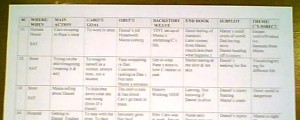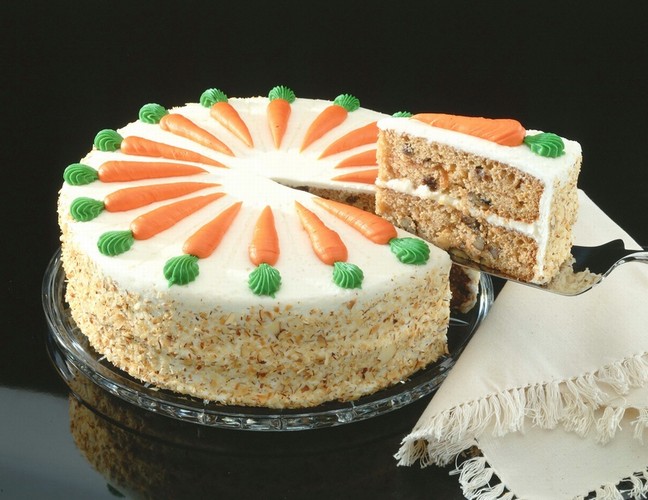Keeping an Eye on the Carrot
This week, and this weekend, I’m plotting my WIP. I’m trying to get as far as I can before Monday, when I’ve promised myself I’ll start actually writing. Here’s what I’ve been working on the past few days. I say “based,” because over the years, I’ve come to realize what categories of info I need to focus on before I write.

The table is based on Martha Alderson’s Scene Tracker, which you can see in her book, Blockbuster Plots, or her other products. Of course, this plot session comes after a lot of research, working my way through Donald Maass’ Writing the Breakout Novel Workbook, and just…thinking. This is the chart, though, that I’ll use to move myself forward (I hope!) through the first draft.
In case you can’t read the headers, I at least think about these things for each scene:
- Where and when the scene takes place
- The main action(s) of the scene
- The MC’s goal–her scene goal, what she wants to accomplish then and now
- Any obstacles to that goal and who’s putting those obstacles in the MC’s path
- What part of the backstory I should/could weave in
This column is new for this book, because the past plays a huge part in the present, and I’m working hard not to just dump it in, but place it, in small drips, where it really belongs. - The “end hook”–how I visualize the scene ending, with a pull for the readers to turn the page
This is another new column. Partially, this is to remind me about cliff-hangers, but it also helps me think about points of high conflict for each scene. - Any subplots I can bring into the scene
- Theme/MC’s Direction toward or away from her goal. Theme is Martha’s column title, and I like to keep it in, because–even if I don’t get anywhere close to plotting in my theme, the column keeps it present in my mind where, hopefully, it simmers. I’ve included, in this same column, whether–by her actions–my MC is stepping toward or away from her goal. Somehow, in my mind, this has become connected with theme. We’ll see!
I let myself be pretty loose with this–it’s almost more of a brainstorming tool than an actual plotting chart. Some of the cells get seriously tall and skinny, as I dump random possibilities and connections into them. The thing to remember, hard as it can be, is that the goal here is almost a kind of anti-perfection. There is too much I don’t, and can’t know, until I start writing–until I’ve finished writing the first, and subsequent drafts. I want to use the info in this chart as a series of guideposts, not as a straight-jacketed path.
So, when I find myself worrying too much about whether my character would do this or that, what piece of history she’ll be interacting with, or even what the weather would be like, I focus on the carrot. The one that’s dangling out in front of me, coaxing me to keep moving forward.
That carrot is that, the more quickly I plot, the more guideposts I’ll be giving myself, the more of that first mess of words I’ll be able to get onto the page, into the computer. I’ll be able to write my first draft with speed, energy, and excitement. And I’ll have room to make some of those magical discoveries as I go.
So, as you plot, keep an eye on your carrot, whatever it may be. Figure out what it is, get a picture in your mind, and write toward it.
Mine, just so you know, looks a lot like this.



16 Comments
This looks like a great tool, Becky! I might have to try this since I keep getting lost in a tangle of all my plots, subplots, and various character arcs. Thanks for posting it!
I especially like your “end hook” addition, a way to check if one scene propels the reader into the next. Brilliant!
LikeLike
Thanks, Robin. That end hook was something I had to work a lot on in the revision on my last book. Thought I’d try and get ahead of myself just a little bit this time around. 🙂
LikeLike
This looks so doable in a giant picture way. Impressive and inspiring. I hope your weekend is as full of accomplishments as you hope.
And the idea of eye on the carrot cake works much better for me than the carrot. Hope to slice some with you soon.
LikeLike
Thanks, Jeannine. Yeah, I said “carrot,” but it’s not the same without the cream cheese frosting. 🙂
LikeLike
Oh, and we’ll have to find carrot cake in Chicago!
LikeLike
Lovely description of a useful tool. The carrot looks more to me like a lovely printed copy of your book standing on my library shelves.
But I’ll take cake in the meantime.
LikeLike
Thanks, Terri. I know–that’s the real carrot, but if I focus too hard on that I start freaking out just a little too much! 🙂
LikeLike
I took Martha’s class and really need to revisit the chart/her book. I’m charting something myself, but it’s an actual calendar for my novel – as it all takes place in about 6 weeks. But it lets me fill in what my MC is doing each day/week so I can see where I need to beef things up or make sure there is enough interaction between certain characters in order for XYZ to happen in week 3, etc. Anyway, happy plotting!
LikeLike
I probably need to do a calendar, too, but mostly for the backstory–which happened 15 years or so before the story! But I need to synch those events up with real history AND the present story up with history, too!
Happy plotting to you, too!
LikeLike
What a great idea. Think I’ll try it from mid-novel on. The carrot cake definitely inspires. Yum!
LikeLike
Judy–Hope it helps! It’s one of the biggest helps for me in getting through the middle–makes me actually get some possible scene ideas on paper. Takes away some of that gaping-hole feeling.
Enjoy the carrot!
LikeLike
Full of salient poitns. Don\’t stop believing or writing!
LikeLike
This is a great tool. How hard was/is it to make the rubric? I do not know spreadsheet or whatever (embarrassing computer moment)
LikeLike
Linda, I’m not any good at spreadsheets either! I use a Word table. Martha’s book (at her website http://www.blockbusterplots.com) has a lot more information on the table and how to use it!
Good luck!
LikeLike
This looks great, Becky. I’m such a “pantser”, but I’m thinking I should at least give plotting a try. Couldn’t hurt, and I’m sure I’ll learn something along the way. Plus, it might be kinda fun! (Ooh, pretty charts! Can I use glitter pens?) 😉
LikeLike
Glitter pens AND neon sticky notes! How’s that? 🙂
LikeLike